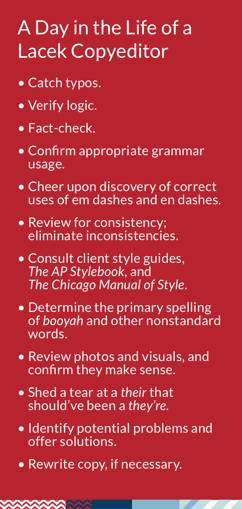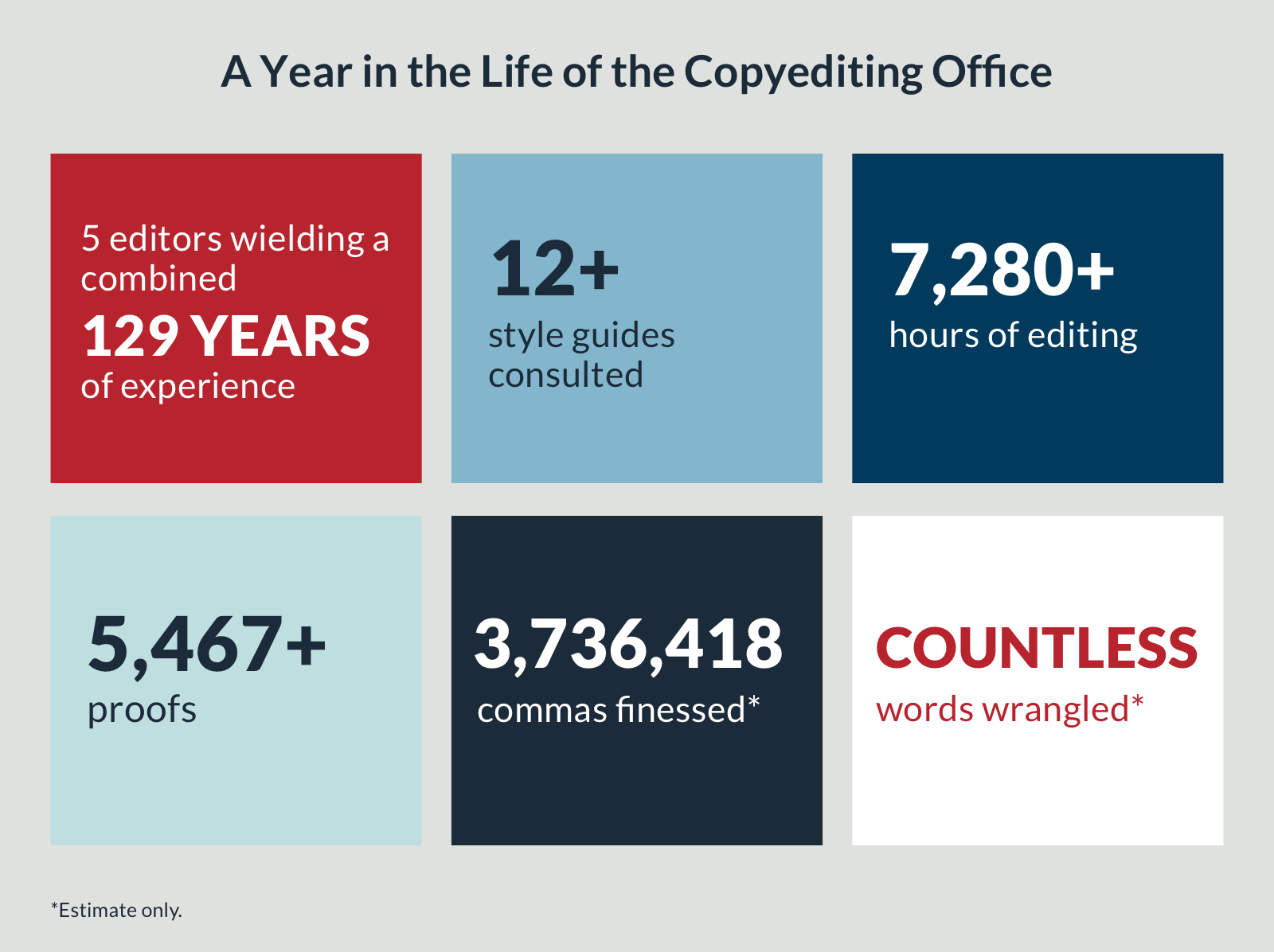Your Copyeditor Is Out to Shame You (and Other Editing Myths)

As copyeditors, we live under a cloud of misconceptions about our work. So we (Lacek’s five copyeditors, a team that boasts more than a century of combined experience) sharpened our pencils to set the record straight—and share insights to help you ensure your communications are the best they can be.
Myth 1: You’re a copyeditor. That’s a proofreader, right?
 Nope. Copyeditor isn’t a synonym for proofreader. But defining what we do is a great launching point.
Nope. Copyeditor isn’t a synonym for proofreader. But defining what we do is a great launching point.
Sometimes copyeditors are tasked with proofreading, but our domain is wider than hunting for typos, punctuation errors, and dropped text. That said, those important tasks can’t be left exclusively to automated word processing. Case in point: Spell-check doesn’t highlight pubic when the intended term is public. Because, of course, pubic is a word—just not one likely to be found in our marketing copy. (This real-life example could’ve been embarrassing for Lacek and our client. Yikes.)
Copyeditors are responsible for finding errors, of course, but we also stay attuned to brand voice and tone. For example, we call it out if copy for The Home Depot sounds too florid or messaging for Carnival Cruise Lines feels too bland. Along with our colleagues in Creative, we help ensure a consistent voice across pieces and channels for every client.
We also make sure each client’s collateral conforms to correct language usage. We do that by consulting The AP Stylebook and The Chicago Manual of Style, the two dominant references for usage in the U.S., plus each client’s brand style guide that outlines placement of legal marks and other brand specifics. That means we have to move between a dozen style guides.
Other key tasks include fact-checking and ensuring accuracy. For example, we confirm spellings of proper nouns (names, cities, organizations, etc.), make sure client offers match terms and conditions copy, align benefits with membership tiers, and so much more. Errors could mean lost revenue, disappointed members, or both—and no one wants that.
Copyeditors also aim to avoid problematic copy, such as inadvertent innuendo, plus sexist, racist, and gendered phrases that could result in a negative response from consumers. A noteworthy example is a headline for a campaign that included the phrase “a little sumpin’ sumpin’”—contemporary slang a bit too suggestive for that client’s audience. After we raised a red flag, the headline was replaced. Amid the current vigilance in holding brands accountable for their values and actions, watching out for problematic language has only grown in importance.
Sometimes we’re called on to compare copy prepared by translators after it’s been flowed into emails or other formats. In fact, for our global hospitality client Marriott Bonvoy, that may mean side-by-side comparisons of up to 11 languages—including some with entirely different characters, such as Arabic, Chinese, and Korean.
Although it’s not a typical part of a copyeditor’s job, sometimes we’re tasked with content editing, which means more heavy-duty editing—considering the copy’s substance, argument, promise, and payoff. This tends to happen when we’re editing a blog or white paper for a client or Lacek’s Thought Leadership initiative. More substantive editing can also be our charge when we collaborate on presentation decks or new-business proposals, which often arrive full of inconsistencies because multiple people have contributed material. In those cases, we pay particular attention to achieving a consistent voice.
Myth 2: Copyeditors play gotcha! They love to criticize.
Nope. Copyeditors simply want the best, clearest, and cleanest copy to be sent out on clients’ behalf. That reflects well on our colleagues and our agency—and is one of the reasons Lacek boasts so many long-term clients.
Sure, we’re invested in finding errors, but we don’t indulge in schoolmarmish finger wagging or do a happy dance every time we find a typo. And we’re not judging anyone’s mistakes. (A look at our personal emails would reveal plenty of on-the-fly missteps. We get it.) But it’s our job to eliminate those blunders from agency and client work.
Our advice: Don’t apologize if you’re the nitpicker of your office. Someone needs to be. You make your whole team look better.
Myth 3: Copyeditors get a nerdy kick out of learning arcane grammar rules and the development of punctuation usage.

OK, this one isn’t a myth. Doesn’t everyone get a little charge out of discovering something new and obscure about language?
Take, for example, the interrobang, the love child of a question mark and an exclamation point. It was devised in Mad Men–era New York City by Madison Avenue adman Martin K. Speckter. Its name merges the “interrogative point,” aka the question mark, and “bang,” typesetter jargon for an exclamation point. (Intriguing, yes?!) Imagine if it had caught on? Then we’d only have to use one punctuation mark when we want to imply incredulity or dismay.
Obscure-but-fascinating punctuation aside, language and its usage continuously evolve. The English of Shakespeare differs from that of Jane Austen, and both seem a fair distance from the prose of Toni Morrison and the tweets of Lady Gaga.
Copyeditors weigh established (even sometimes flexible) rules of grammar against the inevitably shifting trends of common use. And sometimes it’s murky territory. Our constant goal? Clarity, brevity, and readability.
Myth 4: Copyeditors won’t stop with the pretentious vocabulary.
That recrimination remains unwarranted. Copyeditors cultivate as quotidian a vocabulary as the rest of the hoi polloi. (Apologies. Couldn’t resist.)
While we embrace an extensive vocabulary because it encourages precise expression, if we come across a ten-dollar word when an emoji would do the job better, we’ll happily make that suggestion. Or if an accompanying image is doing the work of a thousand words, we’re excited to help trim redundant copy.
Word choice is a central aspect of tone and brand voice—and we’re sensitive to keeping both appropriate for every client’s audience. We’re also conscious of insider speak that may come across as jargon to a general reader. For example, we wouldn’t talk about QSRs (quick-service restaurants) or the CX (customer experience) in member-facing copy.
You might say we maintain an invested objectivity as we edit: invested in the sense that we want to help each piece we read to be as strong as possible for the client, and objective because we’re always trying to read from the recipients’ perspective.

Myth 5: Rules, schmools. Copyediting doesn’t really matter anymore.
Whoa. Slow your roll there, friend. Despite the current Gumby-level flexibility of syntax and word use in casual forms like emails and social media, how language is deployed still matters. In fact, given the rapid changes in grammar and usage, it may be more important than ever to have expert editors navigate the shifting landscape.
We’re often called on to weigh in on thorny or confusing usage topics. That’s especially true for client style guides, which tend to evolve regularly to reflect usage adjustments and changes in client preferences.
Recently, one of our accounts decided to stop using terminal punctuation on headlines. Problem is, we were seeing a number of two-sentence headlines come through. In that case, terminal punctuation is necessary at the end of the sentence, or it seems like a typo. We made a successful case that two-sentence headlines should be an exception to the new rule, so readers across the nation will be spared wondering what happened to those missing punctuation marks.
Myth 6: When a deadline is tight or a project is on round two (or twelve), CEs tap into their speed-reading superpower.
If we had a nickel for every time we hear, “This was copyedited in a previous round, so it should be a quick one,” our donut runs would be more frequent. That’s just not the case.
Copyediting involves comprehensively reading and reviewing all aspects of a piece. It takes us as long to do a full read of an initial copy deck as a third round in layout. That said, the hope is that marking up changes and making queries in subsequent rounds takes less time because fewer issues require comment. But that’s not always the case.
Often changes are made between rounds by the client or account team members, and new errors or questions arise. Or after a first pass of necessary changes, new suggestions become clear.
Asking us to rush—or to mark only “necessary” changes—is akin to asking us to do half our job. In fact, that request may take us even longer because we’re constantly second-guessing what rises to the level of “necessary.”
Myth 7: Editing has rules, so all editors should propose the same changes.
Yes, editors follow and enforce grammar and style guidelines. However, not everything about grammar is clear-cut, and because language is flexible, many missteps or awkward constructions can be rectified in multiple ways. Editing is an extension of writing—and both are fundamentally creative acts.
Lacek’s team approach to copyediting continuously strengthens our client work. As a project goes through our process from a copy deck to a final proof, it’s likely to be picked up by different editors. And, in addition to pointing out obvious errors, the five of us frequently offer different suggestions to help achieve concision, create parallel constructions, land a play on words, smooth out a rhythmic hiccup, and the like.
Consider applying the principle “many hands make light work” to your editing process: Many eyes make stronger messaging.
Myth 8: Editors never miss errors, inconsistencies, or other problems.
Oh, how we wish this were true. We would dearly love to be letter-perfect every single time. That’s our impossible goal—impossible because we’re human. Sometimes we’re tired or distracted or rushing because the queue of work is long and the deadlines are short. But it’s our job to tilt toward the windmill of perfection, and, quixotically, we do.
And avoiding missed errors is another way a team approach to copyediting strengthens our output.
Still, when we discover something we missed, we agonize. Then we file the moment away as a mental reminder to stay vigilant, and the same mistake is highly unlikely to burn us twice.
Whatever the prevailing misconceptions, copyediting is one of the behind-the-scenes tasks that helps Lacek produce strong, accurate, and engaging work for our clients year after year. And, as the resident librarian types of the agency, we’re happy to occupy our quiet corner, continually working to strengthen the client and agency materials that cross our desks. Here’s hoping you have a similar brigade of language polishers on your team.
Carolyn Berge, Karen Butak, Lizzie Daniels, Karin Miller, and Wendy Weckwerth are the copyediting team for The Lacek Group, a Minneapolis-based data-driven loyalty, experience, and customer engagement agency that has been delivering personalization at scale for its world-class clients for more than 30 years. The Lacek Group is an Ogilvy company.

